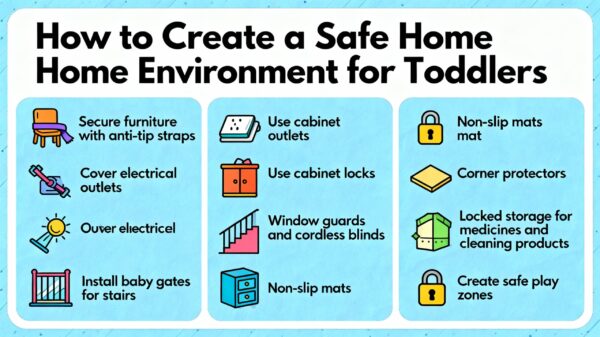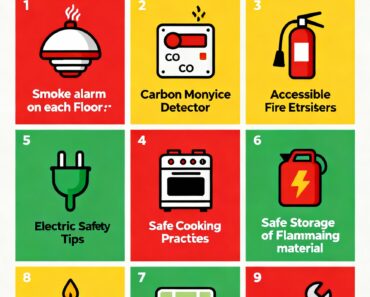Creating a safe home environment for toddlers is essential in fostering their exploration and growth while preventing accidents and injuries. Toddlers are curious and increasingly mobile, which requires vigilant childproofing and safety planning across all rooms in your home. This comprehensive guide offers practical, room-by-room tips to ensure your home supports your toddler’s safety and your peace of mind.
Understanding Toddler Safety Needs
Toddlers develop skills rapidly—they crawl, stand, walk, and explore by putting objects into their mouths. These behaviors increase their risk of falls, choking, burns, poisoning, and other household injuries if preventive measures are not in place. A safe environment balances giving toddlers freedom to explore with necessary protections.
Living and Play Areas
-
Secure Heavy Furniture: Anchor bookshelves, dressers, TV stands, and other heavy items to walls using anti-tip straps to prevent tipping hazards when your toddler tries to climb or pull up on furniture.headstart
-
Electrical Safety: Use outlet covers or sliding plates on all accessible electrical outlets, and hide or fasten cords to prevent chewing and strangulation risks.
-
Window Precautions: Keep furniture away from windows to stop toddlers climbing up. Use window guards or locks to restrict openings to no more than 4 inches (10 cm) to prevent falls. Replace blinds or curtains with cords by cordless alternatives to remove strangulation hazards.childsafetylink+1
-
Toy and Clutter Management: Store toys and small objects in bins or shelves to avoid tripping hazards and choking risks. Regularly inspect toys for damage or small detachable parts.
Kitchen Safety
-
Cabinet Locks: Place childproof locks on cabinets and drawers containing cleaning products, knives, medications, and small objects.
-
Stove and Oven Safety: Use stove knob covers to prevent toddlers from turning burners on accidentally. Always turn pot handles away from edges, and when possible, use back burners.
-
Appliance Management: Unplug appliances when not in use and store cords out of reach to prevent pulling or accidental use.
Bathroom Safety
-
Toilet Locks: Install toilet seat locks to prevent drowning risks.
-
Non-Slip Mats: Use non-slip mats inside and outside tubs or showers to reduce slip and fall accidents.
-
Medication and Cosmetic Storage: Store all medications, razors, and hazardous materials in high cabinets with child locks or behind locked doors.
Bedrooms and Sleeping Areas
-
Safe Sleep Space: Use cribs that meet current safety standards and remove pillows, stuffed animals, and thick bedding that pose suffocation hazards.
-
Bed Safety: For toddlers transitioning out of cribs, use age-appropriate beds with side rails and situate them away from windows and cords.
-
Furniture Placement: Avoid placing climbable furniture near windows or other hazards.
Stairways and Hallways
-
Baby Gates: Secure top and bottom of stairs with sturdy gates; wall-mounted gates at the top are preferred for added safety.
-
Clear Pathways: Remove clutter and obstacles from hallways and stair landings to keep walkways safe.
Outdoor Spaces
-
Play Yard Safety: Ensure outdoor play areas are enclosed and free from sharp tools, pesticides, or poisonous plants.
-
Pools and Water: Fence pools securely; store chemicals and pool equipment out of reach or in locked areas.
General and Miscellaneous Safety Measures
-
Corner Guards and Edge Bumpers: Place padding on sharp furniture edges like tables and countertops to soften impacts.
-
Door Safety: Install door stoppers or pinch guards to prevent hand injuries from slamming doors.
-
Smoke and Carbon Monoxide Detectors: Ensure detectors are installed and maintained, and that escape routes are planned and clear.
-
Secure Guns and Weapons: Store firearms unloaded in locked cabinets separate from ammunition.
-
Chemical Safety: Keep cleaning supplies, detergents, and hazardous substances in locked cabinets or high shelves.
-
Monitor Activities: Always supervise toddlers, especially near water, during meal times, and when using toys or play equipment.
-
Educate Caregivers: Make sure all family members and babysitters understand and follow safety protocols.
Creating Child-Safe Habits
Alongside home modifications, teaching toddlers safe habits according to their development helps them learn boundaries. Toddlers understand simple instructions and begin to learn about dangers. Positive role modeling by adults reinforces safety awareness.
Maintaining Safety Over Time
Childproofing isn’t a one-time task. As toddlers grow, their abilities and curiosities change—continually reassess and update your home’s safety to address new challenges. Routinely check for loose hardware, broken locks, and emerging hazards.
By carefully childproofing every room with these guidelines and maintaining vigilance, you create a nurturing and secure environment for your toddler’s development and your peace of mind. This natural, practical advice is designed to equip parents and caregivers with actionable strategies that maximize safety without stifling exploration.
- https://headstart.gov/safety-practices/article/tips-keeping-infants-toddlers-safe-developmental-guide-home-visitors-toddlers
- https://www.healthychildren.org/English/safety-prevention/at-home/Pages/home-safety-heres-how.aspx
- https://www.firstthingsfirst.org/parent-kit/toddler-safety/
- https://raisingchildren.net.au/toddlers/safety/home-pets/home-safety
- https://www.guidedogs.org.uk/getting-support/information-and-advice/learning-through-play/home-safety-tips-for-parents-with-babies-and-toddlers/
- https://childsafetylink.ca/toddler-safety-1-3-years
- https://www.pampers.co.uk/baby/baby-proofing/article/baby-proofing-your-home
- https://www.nhs.uk/baby/first-aid-and-safety/safety/baby-and-toddler-safety/
- https://www.chkd.org/media/tprev1ie/parents-guide-to-a-safe-home.pdf
- https://saverachildrenhospital.com/child-safety-guide-tips-to-keep-kids-safe-at-home/



